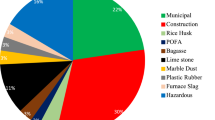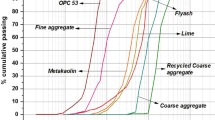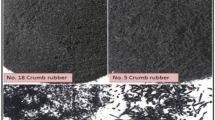Abstract
The disposal of toxic environmental waste is one of the main challenges at present. The use of various kinds of waste as a substitute for aggregate or cement in concrete is a proven way to manage the waste. Various research experiments have been carried out using waste material in self-compacting concrete, resulting in improved strength and resilience, whether it is traditional concrete or self-compacting concrete. This paper highlights the improvements in the durability of self-compacting concrete through the use of different combinations of various waste materials. The study also explains the influence of mineral and chemical admixtures on self-compacting concrete. It also addresses the effect of waste materials, fiber content, and type of admixtures on the durability parameters such as Rapid Chloride Penetration Test (RCPT), sulfate attack, water penetration, and carbonation test on the self-compacting concrete.
Access provided by Autonomous University of Puebla. Download conference paper PDF
Similar content being viewed by others
Keywords
1 Introduction
Self-compacting concrete (SCC) is a front runner of concrete that does not require any vibratory concrete machine to be installed. Because of this concrete consistency, this type of concrete settles under its own weight and is commonly used in the field of construction. Particularly in congested formwork, where compaction is not fissile, it is a good alternative to conventional concrete and work with self-compacting concrete is preferred in this situation.
The use of waste materials from construction industries in making of self-compacting concrete can reduces tons of accumulated construction waste. The present review paper is a research on durability properties of self-compacting concrete after partial replacement of natural aggregates and cementitious content with different mineral admixtures and waste aggregates.
Most research work have shown that partial replacement of cement and natural aggregates with waste mineral admixtures, and waste aggregates improves the durability properties of self-compacting concrete.
2 Review Significance
This paper gives a review on self-compacting concrete (SCC) mix made using various mineral admixtures and materials as partial replacement. A concrete which when poured from a certain height, compacts with its own weight due to gravity and does not require any external vibrations is known as self-compacting concrete. Different authors review papers and case studies are included in this paper, and it shows that effects of minerals admixtures and waste materials on the durability properties of SCC.
The main objective of this review is to find the change in durability of SCC on partial replacement of cement and aggregates with mineral admixtures and recycled materials.
3 Materials Used
Table 1 shows variety of material used by the authors in their research work, which gives a better understanding of different combination and effects of proportions of mineral admixtures and waste/recycled aggregates on the durability of SCC. A detailed review of 145 mixes is done in this study where 23 research studies are reported. Table 2 shows the mix design proportion used by different authors. The cement that was used widely for mix design was Ordinary Portland Cement. Mineral admixtures are also used in different combination with OPC. Fly ash, limestone powder, rice husk ash, pumice, zeolite, coal fly ash, silicon fillers, metakaolin, and waste asphalt filler was used in specific proportion with OPC.
Here, Fig. 1 shows the frequency of mineral admixtures used with the cement by different authors. It clearly shows that frequency of fly ash with cement and limestone powder with cement is used the most at 28 and 22%, respectively. Another frequently used material is metakaolin at 14%. The graph shows that fly ash, limestone powder, and metakaolin was used frequently in combination with OPC and other mineral admixtures by most authors.
In some SCC mixes, addition of silica fume and rice husk ash are used as mineral admixture in specific proportion. Pumice in SCC has superior resistance to harsh weather conditions like freezing and thawing. Pumice powder has pozzolanic properties, especially if it is used as combination with silica fume.
Figure 2 shows the frequency of materials used as partial replacement to natural aggregates by different authors. Recycled concrete aggregates were used frequently by authors in combination with natural aggregates. Other materials used as partial replacement to natural aggregates include bottom ash, copper slag, marble aggregate, and artificial aggregate.
4 Durability Test
4.1 Carbonation Depth Test
The process in which atmospheric carbon-dioxide (CO2) reacts with hydrated cementitious mineral in the presence of moisture is known as carbonation. Calcium carbonate is formed when calcium hydroxide and carbon dioxide reacts together. Carbonation prevents corrosion of reinforcement as it reduces alkalinity and increases mechanical strength. Carbonation proves to be not good for concrete structure.
To check for carbonation depth, multiple specimens are prepared for different mix designs. After respective days of curing, cube specimens were split prior to testing, conditioning of specimen was done. Phenolphthalein was used as an indicator for carbonation, and then the depth of carbonation was measured. Figure 3 shows the result obtained by different authors for the carbonation test performed by on their mix samples.
4.2 Rapid Chloride Penetration Test
Chloride penetration leads to corrosion of reinforced steel and corrosion related damages to concrete, and it is a very common issue. This issue of durability has drawn attention toward it due to its frequent occurrence and high repair costs. Chlorides will even penetrate a crack free concrete by kind of mechanisms appreciate capillary absorption, fluid mechanics pressure, diffusion, etc. Diffusion is caused once the chloride concentration on the skin of the SCC concrete structure is higher than that on the inside.
For the purpose of Rapid Chloride Penetration Test (RCPT), cylindrical specimens of self-compacting concrete were selected (100 mm diameter, 50 mm thick). As per ASTM C1202, the tests were conducted at different intervals. The results obtained by different authors are shown in Fig. 4. Table 3 shows Chloride ion penetrability based on charge passed (ASTM 1202-97).
4.3 Sulfate Attack Test
According to ASTM C1012, the test for checking percentage mass change due to sulfate attack was performed. Cube specimens of size 150 mm × 150 mm × 150 mm were immersed in 5% Na2SO4 solution. Change in weight percentage of the specimens were noted down at an exposure period of 28, 56, 90, 120, and 365 days. Figure 5 shows the result for sulfate attack test performed by various authors on their respective mixes.
4.4 Water Penetration Test
According to BSEN12390-8:2000, specimen of size 150 mm × 150 mm × 150 mm were selected for curing ages of 28, 56 and 120 days. A constant water pressure of 0.5 MPa was maintained over the specimen for 72 h. After 72 h, the specimens need to be removed from the apparatus and needs to split in two halves, perpendicular to the face on which the water pressure was applied. As soon as the split face had dried to such an extent that the water penetration front could be clearly seen, the waterfront was marked on the specimen. The reading for maximum water penetration depth was recorded to the nearest millimeter. The result of depth of penetration performed by different author son their mix is reported in Fig. 6.
5 Conclusion
By reviewing all the papers, it was concluded that addition of waste/recycled aggregates and mineral admixtures as partial replacement to cement and natural aggregates will improve the durability properties of self-compacting concrete. As shown in the tables and figures, it is clear that most suitable cement used is ordinary Portland cement in combination with various mineral admixtures such as fly ash, silica fumes, limestone powder, silica fumes, etc. The use of super plasticizer or high range water reducer to maintain the lower water to cement or water to powder ratio and achieve desired property to qualify as a SCC. Following inferences were derived from the study:
-
Addition of recycle concrete aggregates reduces the durability of self-compacting concrete mix, but on addition of 30% of total binding material as powdered mineral admixtures such as fly ash, metakaolin, silica fumes or combination of the three, alongside recycled aggregates makes the specimen less vulnerable to chemical attacks;
-
Addition of 10% metakaolin along with 20% fly ash or limestone powder to the mix increases the resistance of mix against carbonation by 17.5%, rapid chloride ion penetration by 60% and water penetration by 10%;
-
Addition of 20% silica fumes in self-compacting concrete increases resistance against carbonation up to 70%, chloride ion penetration by up to 70% and water penetration by up to 10%;
-
Addition of steel fibers in self-compacting concrete reduces resistance against carbonation attack by up to 20%.
-
Major change in properties were observed when 30% fly ash was added as partial replacement to cement. Fly ash decreases the coulomb value of concrete in rapid chloride penetration test from 3000 coulombs to below 1000 coulombs which lies in very low range of chloride ion penetration according to ASTM 1202-97.
-
Addition of 15% rice husk ash reduced the penetration of chloride ions by up to 80%. 15% was found to be optimum value of rice husk ash, increase or decrease in this value reduced the resistance of the mix. It was also found that every mix with rice husk ash lied in very low range of chloride ion penetration.
Abbreviations
- NM:
-
Not Mentioned
- OPC:
-
Ordinary Portland Cement
- SP:
-
Super-Plasticizer
- FA:
-
Fly Ash
- BA:
-
Bottom Ash
- LF:
-
Limestone Filler
- FS:
-
Fine River Sand
- PC:
-
Portland Cement
- RCA:
-
Recycled concrete aggregate
- PCE:
-
Polycarboxylate Ether
- RHA:
-
Rice Husk Ash
- MK:
-
Metakaolin
- SNP:
-
Sulphonated Naphthalene Polymer
- LP:
-
Limestone Powder
- FO:
-
Fatty Oils
- SF:
-
Silica Fumes
- CS:
-
Copper Slag
- MA:
-
Marble Aggregate
- AA:
-
Artificial Aggregate
- RA:
-
Recycled Aggregate
References
Siddique, R. (2013). Compressive strength, water absorption, sorptivity, abrasion resistance and permeability of self-compacting concrete containing coal bottom ash. Construction and Building Materials, 47, 1444–1450.
Frazão, C., Camões, A., Barros, J., & Gonçalves, D. (2015). Durability of steel fiber reinforced self-compacting concrete. Construction and Building Materials, 80, 155–166.
Singh, N., & Singh, S. P. (2016). Carbonation and electrical resistance of self compacting concrete made with recycled concrete aggregates and metakaolin. Construction and Building Materials, 121, 400–409.
Kapoor, K., Singh, S. P., & Singh, B. (2016). Durability of self-compacting concrete made with recycled concrete aggregates and mineral admixtures. Construction and Building Materials, 128, 67–76.
Kannan, V., & Ganesan, K. (2014). Chloride and chemical resistance of self compacting concrete containing rice husk ash and metakaolin. Construction and Building Materials, 51, 225–234.
Samimi, K., Kamali-Bernard, S., Maghsoudi, A. A., Maghsoudi, M., & Siad, H. (2017). Influence of pumice and zeolite on compressive strength, transport properties and resistance to chloride penetration of high strength self-compacting concretes. Construction and Building Materials, 151, 292–311.
Kou, S. C., & Poon, C. S. (2009). Properties of self-compacting concrete prepared with coarse and fine recycled concrete aggregates. Cement and Concrete composites, 31(9), 622–627.
Persson, B. (2003). Sulphate resistance of self-compacting concrete. Cement and Concrete Research, 33(12), 1933–1938.
Gupta, N., & Siddique, R. (2020). Durability characteristics of self-compacting concrete made with copper slag. Construction and Building Materials, 247, 118580.
Siddique, R. (2011). Properties of self-compacting concrete containing class F fly ash. Materials and Design, 32(3), 1501–1507.
Sharma, R., & Khan, R. A. (2017). Durability assessment of self compacting concrete incorporating copper slag as fine aggregates. Construction and Building Materials, 155, 617–629.
Pereira-de-Oliveira, L. A., Nepomuceno, M. C. S., Castro-Gomes, J. P., & Vila, M. D. F. C. (2014). Permeability properties of self-compacting concrete with coarse recycled aggregates. Construction and Building Materials, 51, 113–120.
Chopra, D., & Siddique, R. (2015). Strength, permeability and microstructure of self-compacting concrete containing rice husk ash. Biosystems Engineering, 130, 72–80.
Assie, S., Escadeillas, G., & Waller, V. (2007). Estimates of self-compacting concrete ‘potential’ durability. Construction and Building Materials, 21(10), 1909–1917.
Valcuende, M., & Parra, C. (2010). Natural carbonation of self-compacting concretes. Construction and Building Materials, 24(5), 848–853.
Esquinas, A. R., Alvarez, J. I., Jiménez, J. R., & Fernández, J. M. (2018). Durability of self-compacting concrete made from non-conforming fly ash from coal-fired power plants. Construction and Building Materials, 189, 993–1006.
Esquinas, A. R., Álvarez, J. I., Jiménez, J. R., Fernández, J. M., & De Brito, J. (2018). Durability of self-compacting concrete made with recovery filler from hot-mix asphalt plants. Construction and Building Materials, 161, 407–419.
Gill, A. S., & Siddique, R. (2018). Durability properties of self-compacting concrete incorporating metakaolin and rice husk ash. Construction and Building Materials, 176, 323–332.
Sasanipour, H., Aslani, F., &Taherinezhad, J. (2019). Effect of silica fume on durability of self-compacting concrete made with waste recycled concrete aggregates. Construction and Building Materials, 227, 116598.
Ofuyatan, O. M., Olutoge, F. A., & Olowofoyeku, O. A. (2015). Durability properties of palm oil fuel ash self compacting concrete. Engineering, Technology and Applied Science Research, 5(1), 753–756.
Vaidevi, C., Kala, T. F., & Kalaiyarrasi, A. R. R. (2020). Mechanical and durability properties of self-compacting concrete with marble fine aggregate. Materials Today: Proceedings, 22, 829–835.
Tang, P., & Brouwers, H. J. H. (2018). The durability and environmental properties of self-compacting concrete incorporating cold bonded lightweight aggregates produced from combined industrial solid wastes. Construction and Building Materials, 167, 271–285.
Kapoor, K., Singh, S. P., & Singh, B. (2018). Water permeation properties of self compacting concrete made with coarse and fine recycled concrete aggregates. International Journal of Civil Engineering, 16(1), 47–56.
Author information
Authors and Affiliations
Corresponding author
Editor information
Editors and Affiliations
Rights and permissions
Copyright information
© 2022 Springer Nature Singapore Pte Ltd.
About this paper
Cite this paper
Raj, R., Bhat, M., Agrawal, A., Chandak, N. (2022). Review on the Durability Parameters of Self-compacting Concrete. In: Gupta, A.K., Shukla, S.K., Azamathulla, H. (eds) Advances in Construction Materials and Sustainable Environment. Lecture Notes in Civil Engineering, vol 196. Springer, Singapore. https://doi.org/10.1007/978-981-16-6557-8_18
Download citation
DOI: https://doi.org/10.1007/978-981-16-6557-8_18
Published:
Publisher Name: Springer, Singapore
Print ISBN: 978-981-16-6556-1
Online ISBN: 978-981-16-6557-8
eBook Packages: EngineeringEngineering (R0)










